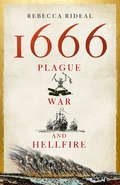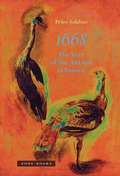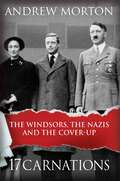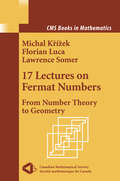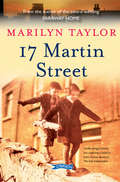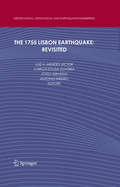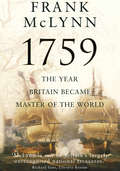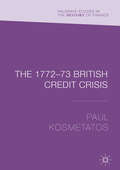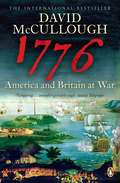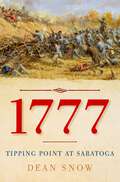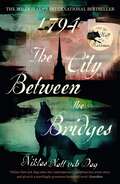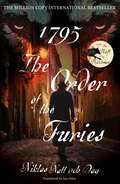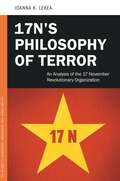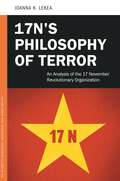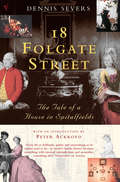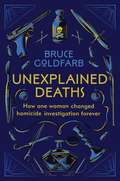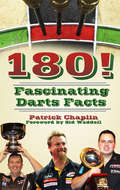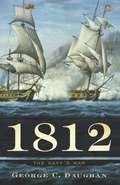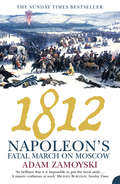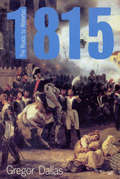- Table View
- List View
1666: Plague, War and Hellfire (Not A Ser.)
by Rebecca Rideal1666 was a watershed year for England. The outbreak of the Great Plague, the eruption of the second Dutch War and the Great Fire of London all struck the country in rapid succession and with devastating repercussions.Shedding light on these dramatic events, historian Rebecca Rideal reveals an unprecedented period of terror and triumph. Based on original archival research and drawing on little-known sources, 1666: Plague, War and Hellfire takes readers on a thrilling journey through a crucial turning point in English history, as seen through the eyes of an extraordinary cast of historical characters. While the central events of this significant year were ones of devastation and defeat, 1666 also offers a glimpse of the incredible scientific and artistic progress being made at that time, from Isaac Newton's discovery of gravity to Robert Hooke's microscopic wonders. It was in this year that John Milton completed Paradise Lost, Frances Stewart posed for the now-iconic image of Britannia, and a young architect named Christopher Wren proposed a plan for a new London - a stone phoenix to rise from the charred ashes of the old city.With flair and style, 1666 shows a city and a country on the cusp of modernity, and a series of events that forever altered the course of history.
1668: The Year of the Animal in France (Zone Bks.)
by Peter SahlinsPeter Sahlins’s brilliant new book reveals the remarkable and understudied “animal moment” in and around 1668 in which authors (including La Fontaine, whose Fables appeared in that year), anatomists, painters, sculptors, and especially the young Louis XIV turned their attention to nonhuman beings.At the center of the Year of the Animal was the Royal Menagerie in the gardens of Versailles, dominated by exotic and graceful birds. In the remarkable unfolding of his original and sophisticated argument, Sahlins shows how the animal bodies of the menagerie and others (such as the dogs and lambs of the first xenotransfusion experiments) were critical to a dramatic rethinking of governance, nature, and the human.The animals of 1668 helped to shift an entire worldview in France — what Sahlins calls Renaissance humanimalism — toward more modern expressions of Classical naturalism and mechanism. In the wake of 1668 came the debasement of animals and the strengthening of human animality, including in Descartes’s animal-machine, highly contested during the Year of the Animal.At the same time, Louis XIV and his intellectual servants used the animals of Versailles to develop and then to transform the symbolic language of French absolutism. Louis XIV came to adopt a model of sovereignty after 1668 where his absolute authority is represented in manifold ways with the bodies of animals and justified by the bestial nature of his human subjects.1668: The Year of the Animal in France explores and reproduces the king’s animal collections — in printed text, weaving, poetry, and engraving, all seen from a unique interdisciplinary perspective. Sahlins brings the animals of 1668 together and to life as he observes them critically in their native habitats — within the animal palace itself by Louis Le Vau, the paintings and tapestries of Charles Le Brun, the garden installations of André Le Nôtre, the literary work of Charles Perrault and the natural history of his brother Claude, the poetry of Madeleine de Scudéry, the philosophy of René Descartes, the engravings of Sébastien Leclerc, the trans_fusion experiments of Jean Denis, and others.The author joins the non_human and human agents of 1668 — panthers and painters, swans and scientists, weasels and weavers — in a learned and sophisticated treatment that will engage scholars and students of early modern France and Europe and readers broadly interested in the subject of animals in human history.
17 Carnations: The Windsors, The Nazis and The Cover-Up
by Andrew MortonThe true story of Edward Windsor and Wallis Simpson’s involvement with the Nazi regime, and the post-war cover-up.The story of the love affair between Wallis Simpson and King Edward VIII, and his abdication, has provoked endless fascination. However, the full story of their links with the German aristocracy and Hitler has remained untold.* 17 Carnations chronicles Hitler’s attempts to matchmake between Edward and a German noblewoman, and Wallis’s affair with the German foreign minister, who sent her a carnation for every night they had spent together. *Pro-German sympathizers, the couple became embroiled in a conspiracy to install Edward as a puppet king after the Allies’ defeat.* The Duke’s letters were hidden for years as the British establishment attempted to cover up the connection between the House of Windsor and Hitler.Thoroughly researched, 17 Carnations reveals the whole fascinating story, throwing sharp new light on this dark chapter of history.
17 Lectures on Fermat Numbers: From Number Theory to Geometry (CMS Books in Mathematics)
by Michal Krizek Florian Luca Lawrence SomerThe pioneering work of Pierre de Fermat has attracted the attention of mathematicians for over 350 years. This book provides an overview of the many properties of Fermat numbers and demonstrates their applications in areas such as number theory, probability theory, geometry, and signal processing. It is an ideal introduction to the basic mathematical ideas and algebraic methods connected with the Fermat numbers.
17 Martin Street
by Marilyn TaylorA web of secrets can risk lives … When Hetty’s family move to Martin Street near Portobello bridge in Dublin, they’re not sure of their welcome. And next door, Ben’s family are not sure about their new Jewish neighbours: it’s The Emergency and they are suspicious of strangers. But for Ben, the chance to earn a few pence is too great and secretly he does odd jobs for them. And there’s a bigger secret: Renata, a World War Two refugee, is on the run in the city. Hetty is determined to rescue her. The web of secrets begins to unravel and there are lives at risk. Can Hetty and Ben overcome their differences and save Renata, or are they just meddling in things they know too little about?
The 1711 Expedition to Quebec: Politics and the Limitations of British Global Strategy (Bloomsbury Studies in Military History)
by Adam LyonsIn 1711, the newly formed Great Britain launched its first attempt to conquer French North America. The largest military force ever assembled to fight on the continent was dispatched and combined with colonial American units in Boston before proceeding up the St Lawrence River for Quebec. An additional colonial force set out from Albany to march on Montreal - but neither Briton nor colonist reached their respective targets.Adam Lyons looks at the expedition as a product of the turbulent political environment at the end of Queen Anne's reign and as a symbol of a shift in politics and strategy. Its failure proved to be detrimental to the reputation of the expedition's naval commander, Rear-Admiral Sir Hovenden Walker, but Lyons shows how true blame should lie with his political master, Secretary of State Henry St John, who ensured the expedition's failure by maintaining absolute control and secrecy. The 1711 Expedition to Quebec demonstrates how the expedition helped to alter British policy by renewing an interest in 'blue water', or maritime, operations that would gain dominance for Britain in commerce and at sea. This strategy would later see huge success, ultimately resulting in the fall of Quebec to Wolfe and the eventual conquest of French North America in the Seven Years War.
The 1711 Expedition to Quebec: Politics and the Limitations of British Global Strategy (Bloomsbury Studies in Military History)
by Adam LyonsIn 1711, the newly formed Great Britain launched its first attempt to conquer French North America. The largest military force ever assembled to fight on the continent was dispatched and combined with colonial American units in Boston before proceeding up the St Lawrence River for Quebec. An additional colonial force set out from Albany to march on Montreal - but neither Briton nor colonist reached their respective targets.Adam Lyons looks at the expedition as a product of the turbulent political environment at the end of Queen Anne's reign and as a symbol of a shift in politics and strategy. Its failure proved to be detrimental to the reputation of the expedition's naval commander, Rear-Admiral Sir Hovenden Walker, but Lyons shows how true blame should lie with his political master, Secretary of State Henry St John, who ensured the expedition's failure by maintaining absolute control and secrecy. The 1711 Expedition to Quebec demonstrates how the expedition helped to alter British policy by renewing an interest in 'blue water', or maritime, operations that would gain dominance for Britain in commerce and at sea. This strategy would later see huge success, ultimately resulting in the fall of Quebec to Wolfe and the eventual conquest of French North America in the Seven Years War.
The 1755 Lisbon Earthquake: Revisited (Geotechnical, Geological and Earthquake Engineering #7)
by João Azevedo A. Ribeiro Luiz Mendes-Victor Carlos Sousa OliveiraThe 1755 earthquake and tsunami were influential not only in Portugal but in all European and North African countries where the devastating effects were felt. The entire world was deeply impressed and the discussion of its causes generated a large amount of scientific and metaphysical speculation. It inspired philosophers, poets and writers. The socio-economic consequences of the event were great and affected the future organization and development of Portugal. The possibility of a similar occurence urges society and the scientific community to reflect on its lessons. AudienceThis work is of interest to experts in seismology, earthquake engineering, civil protection, urban planning and it is a reference book for doctoral students.
1759: The Year Britain Became Master of the World
by Frank McLynnAlthough 1759 is not a date as well known in British history as 1215, 1588, or 1688, there is a strong case to be made that it is the most significant year since 1066. In 1759 - the fourth year of the Seven Years War - the British defeated the French in arduous campaigns on four continents and also achieved absolute mastery of the seas.Drawing on a mass of primary materials - from texts in the Vatican archives to oral histories of the North American Indians - Frank McLynn shows how the conflict between Brtiain and France triggered the first 'world war', raging from Europe to Africa; the Caribbean to the Pacific; the plains of the Ganges to the Great Lakes of North America. It also brought about the War of Independence, the acquisition by Britain of the Falkland Islands and, ultimately, the French Revolution.
The 1772–73 British Credit Crisis (Palgrave Studies in the History of Finance)
by Paul KosmetatosNowadays remembered mostly through Adam Smith’s references to the short-lived Ayr Bank in the Wealth of Nations, the 1772-3 financial crisis was an important historical episode in its own right, taking place during a pivotal period in the development of financial capitalism and coinciding with the start of the traditional industrialisation narrative. It was also one of the earliest purely financial crises occurring in peacetime, and its progress showed an impressive geographical reach, involving England, Scotland, the Netherlands and the North American colonies. This book uses a variety of previously unpublished archival sources to question the bubble narrative usually associated with this crisis, and to identify the mechanisms of financial contagion that allowed the failure of a small private bank in London to cause rapid and severe distress throughout the 18th century financial system. It re-examines the short and turbulent career of the Ayr Bank, and concludes that its failure was the result of cavalier liability management akin to that of Northern Rock in 2007, rather than the poor asset quality alleged in existing literature. It furthermore argues that the Bank of England’s prompt efforts to contain the crisis are evidence of a Lender of Last Resort in action, some thirty years before the classical formulation of the concept by Henry Thornton.
The 1772–73 British Credit Crisis (Palgrave Studies in the History of Finance)
by Paul KosmetatosNowadays remembered mostly through Adam Smith’s references to the short-lived Ayr Bank in the Wealth of Nations, the 1772-3 financial crisis was an important historical episode in its own right, taking place during a pivotal period in the development of financial capitalism and coinciding with the start of the traditional industrialisation narrative. It was also one of the earliest purely financial crises occurring in peacetime, and its progress showed an impressive geographical reach, involving England, Scotland, the Netherlands and the North American colonies. This book uses a variety of previously unpublished archival sources to question the bubble narrative usually associated with this crisis, and to identify the mechanisms of financial contagion that allowed the failure of a small private bank in London to cause rapid and severe distress throughout the 18th century financial system. It re-examines the short and turbulent career of the Ayr Bank, and concludes that its failure was the result of cavalier liability management akin to that of Northern Rock in 2007, rather than the poor asset quality alleged in existing literature. It furthermore argues that the Bank of England’s prompt efforts to contain the crisis are evidence of a Lender of Last Resort in action, some thirty years before the classical formulation of the concept by Henry Thornton.
1776: America and Britain at War
by David McCulloughAmerica's most acclaimed historian presents the intricate story of the year of the birth of the United States of America. 1776 tells two gripping stories: how a group of squabbling, disparate colonies became the United States, and how the British Empire tried to stop them. A story with a cast of amazing characters from George III to George Washington, to soldiers and their families, this exhilarating book is one of the great pieces of historical narrative.
1777: Tipping Point at Saratoga
by Dean SnowIn the autumn of 1777, near Saratoga, New York, an inexperienced and improvised American army led by General Horatio Gates faced off against the highly trained British and German forces led by General John Burgoyne. The British strategy in confronting the Americans in upstate New York was to separate rebellious New England from the other colonies. Despite inferior organization and training, the Americans exploited access to fresh reinforcements of men and materiel, and ultimately handed the British a stunning defeat. The American victory, for the first time in the war, confirmed that independence from Great Britain was all but inevitable. Assimilating the archaeological remains from the battlefield along with the many letters, journals, and memoirs of the men and women in both camps, Dean Snow's 1777 provides a richly detailed narrative of the two battles fought at Saratoga over the course of thirty-three tense and bloody days. While the contrasting personalities of Gates and Burgoyne are well known, they are but two of the many actors who make up the larger drama of Saratoga. Snow highlights famous and obscure participants alike, from the brave but now notorious turncoat Benedict Arnold to Frederika von Riedesel, the wife of a British major general who later wrote an important eyewitness account of the battles. Snow, an archaeologist who excavated on the Saratoga battlefield, combines a vivid sense of time and place with details on weather, terrain, and technology and a keen understanding of the adversaries' motivations, challenges, and heroism into a suspenseful, novel-like account. A must-read for anyone with an interest in American history, 1777 is an intimate retelling of the campaign that tipped the balance in the American War of Independence.
1777: Tipping Point at Saratoga
by Dean SnowIn the autumn of 1777, near Saratoga, New York, an inexperienced and improvised American army led by General Horatio Gates faced off against the highly trained British and German forces led by General John Burgoyne. The British strategy in confronting the Americans in upstate New York was to separate rebellious New England from the other colonies. Despite inferior organization and training, the Americans exploited access to fresh reinforcements of men and materiel, and ultimately handed the British a stunning defeat. The American victory, for the first time in the war, confirmed that independence from Great Britain was all but inevitable. Assimilating the archaeological remains from the battlefield along with the many letters, journals, and memoirs of the men and women in both camps, Dean Snow's 1777 provides a richly detailed narrative of the two battles fought at Saratoga over the course of thirty-three tense and bloody days. While the contrasting personalities of Gates and Burgoyne are well known, they are but two of the many actors who make up the larger drama of Saratoga. Snow highlights famous and obscure participants alike, from the brave but now notorious turncoat Benedict Arnold to Frederika von Riedesel, the wife of a British major general who later wrote an important eyewitness account of the battles. Snow, an archaeologist who excavated on the Saratoga battlefield, combines a vivid sense of time and place with details on weather, terrain, and technology and a keen understanding of the adversaries' motivations, challenges, and heroism into a suspenseful, novel-like account. A must-read for anyone with an interest in American history, 1777 is an intimate retelling of the campaign that tipped the balance in the American War of Independence.
1794: The Million Copy International Bestseller (Jean Mickel Cardell #2)
by Niklas Natt Dag#1 bestseller in Sweden with over 1.5 million copies sold'Niklas Natt och Dag takes the contemporary Scandinavian crime story and gives it a startlingly gruesome historical twist' GuardianThe year is 1794. A young nobleman, Eric Three Roses, languishes in hospital. Some think he would be just at home in the madhouse across the road. Ridden with guilt, he spends his nights writing down memories of his lost love who died on their wedding night. Her mother also mourns her and when no one listens to her suspicions, she begs the aid of the only person who will listen: Jean Mickel Cardell, the one-armed watchman.Cecil Winge is six months in the ground but when his younger brother Emil seeks out the watchman to retrieve his brother's missing pocket watch, Cardell enlists his help to discover what really happened at Three Roses' estate that night. But, unlike his dead brother, the younger Winge is an enigma, and Cardell soon realises that he may be more hindrance than help. And when they discover that a mysterious slave trader has been running Three Roses' affairs, it is a race against time to discover the truth before it's too late.In 1794, the second installment of Niklas Natt och Dag's historical noir trilogy, we are reunited with Mickel Cardell, Anna Stina Knapp, and the bustling world of late eighteenth century Stockholm from The Wolf and the Watchman. The city is about to see its darkest days yet as veneers crack and the splendour of old gives way to what is hiding in the city's nooks and crannies.
1795: The Order of the Furies (Jean Mickel Cardell #3)
by Niklas Natt Dag'Niklas Natt och Dag takes the contemporary Scandinavian crime story and gives it a startlingly gruesome historical twist' GuardianIt is 1795 and evil lurks in the winding alleys of Stockholm. Tycho Ceton prowls the city, willing to do anything to survive and reclaim the honour he has lost. No one knows what he is planning next but Emil Winge, haunted by the ghosts of his past, is determined to stop him. Meanwhile, Jean Mickel Cardell is preoccupied with his own search for Anna Stina Knapp. She may have in her possession a letter which could have devastating consequences in the wrong hands.All the while, hell looms inexorably . . .In 1795: The Order of the Furies, the third instalment of Niklas Natt och Dag's historical noir trilogy, we are plunged once again into the bustling world of late eighteenth-century Stockholm. The city is teetering on a precipice, with evil shaking its core, but can love and friendship prevail?Translated by Ian Giles
17N's Philosophy of Terror: An Analysis of the 17 November Revolutionary Organization (PSI Guides to Terrorists, Insurgents, and Armed Groups)
by Ioanne K. LekeaThis book uses a cross-disciplinary approach to examine the creation, development, ideology, and practice of the Marxist terrorist group 17N.Were the members of 17N individuals with high moral principles, as they claimed, who did their best to protect the civilians who happened to be within their field of operations? Or were they simply violent guerillas who prioritized successful assassinations of their targets at any cost? The textual analysis of this book addresses these questions and studies 17N from inception to the time when its members were arrested, providing a uniquely thorough examination of the organization manifestos and its correlation to the group's ideology and actual practices.17N's Philosophy of Terror: An Analysis of the 17 November Revolutionary Organization first outlines the political and ideological framework of 17? and then describes their terrorist strategy and tactics. The authors consider these operations in the context of the manifestos that followed the terrorist acts, and conclude the work by addressing the events following the apprehension of 17N members—the trial, the verdicts, the appeal trial, and the conclusion of appeal trial.
17N's Philosophy of Terror: An Analysis of the 17 November Revolutionary Organization (PSI Guides to Terrorists, Insurgents, and Armed Groups)
by Ioanne K. LekeaThis book uses a cross-disciplinary approach to examine the creation, development, ideology, and practice of the Marxist terrorist group 17N.Were the members of 17N individuals with high moral principles, as they claimed, who did their best to protect the civilians who happened to be within their field of operations? Or were they simply violent guerillas who prioritized successful assassinations of their targets at any cost? The textual analysis of this book addresses these questions and studies 17N from inception to the time when its members were arrested, providing a uniquely thorough examination of the organization manifestos and its correlation to the group's ideology and actual practices.17N's Philosophy of Terror: An Analysis of the 17 November Revolutionary Organization first outlines the political and ideological framework of 17? and then describes their terrorist strategy and tactics. The authors consider these operations in the context of the manifestos that followed the terrorist acts, and conclude the work by addressing the events following the apprehension of 17N members—the trial, the verdicts, the appeal trial, and the conclusion of appeal trial.
18 Folgate Street: The Life of a House in Spitalfields
by Dennis SeversGrowing up in California, Dennis Severs fell in love with the England he saw in old black and white movies. At seventeen he came to London, looking for a home with a heart. In 1979 he found one, a run-down silk-weaver's house in Spitalfields, and over the next twenty years he transformed it into an enchanted time-capsule, transporting us back to the eighteenth century. From cellar to roof, he filled 18 Folgate Street with original objects and furniture, found in the local markets, lit by candles and chandeliers. More than that, he invented a family to live here, the Jervis family, Huguenot weavers who fled persecution in France in 1688, and bought the house in 1724. Sounds and scents bring their world to life, always just out of sight - floorboards creak, fires crackle, a kettle hisses on the hob. Visitors step through the frame of time, like entering an old master painting. As we move from room to room on a tour you will never forget, we follow the Jervis story from the days of the Georges and the Regency to harsher Victorian times - and even to the attic room of Scrooge himself.
18 Tiny Deaths: The Untold Story of Frances Glessner Lee and the Invention of Modern Forensics
by Bruce GoldfarbFor most of human history, sudden and unexpected deaths of a suspicious nature, when they were investigated at all, were examined by lay persons without any formal training. People often got away with murder. Modern forensic investigation originates with Frances Glessner Lee - a pivotal figure in police science.Frances Glessner Lee (1878-1962), born a socialite to a wealthy and influential Chicago family, was never meant to have a career, let alone one steeped in death and depravity. Yet she became the mother of modern forensics and was instrumental in elevating homicide investigation to a scientific discipline. Frances Glessner Lee learned forensic science under the tutelage of pioneering medical examiner Magrath - he told her about his cases, gave her access to the autopsy room to observe post-mortems and taught her about poisons and patterns of injury. A voracious reader too, Lee acquired and read books on criminology and forensic science - eventually establishing the largest library of legal medicine. Lee went on to create The Nutshell Studies of Unexplained Death - a series of dollhouse-sized crime scene dioramas depicting the facts of actual cases in exquisitely detailed miniature - and perhaps the thing she is most famous for. Celebrated by artists, miniaturists and scientists, the Nutshell Studies are a singularly unusual collection. They were first used as a teaching tool in homicide seminars at Harvard Medical School in the 1930s, and then in 1945 the homicide seminar for police detectives that is the longest-running and still the highest-regarded training of its kind in America. Both of which were established by the pioneering Lee.In 18 Tiny Deaths, Bruce Goldfarb weaves Lee's remarkable story with the advances in forensics made in her lifetime to tell the tale of the birth of modern forensics.
180! Fascinating Darts Facts: Fascinating Darts Facts
by Patrick ChaplinIn 180! Fascinating Darts Facts Patrick Chaplin delves deep into his mind-boggling archive to present a plethora of nuggets of darting trivia never before gathered together in book form. Find out . . . Why are darts matches usually played as -01 games (1,001, 501, 301, etc) and not 1,000, 500 or 300? Were early dartboards really made of pig-bristle? Who was the first darts player to endorse a darts product? Why did a Bolton darts team go ‘topless’ in the 1990s? The answers to these and many other darts questions can be found in this book. From the big guns of yesteryear to the stars of the modern game and from the sport’s history and origins to fans drinking a world darts venue dry, it’s all here in 180! Fascinating Darts Facts.
1812: The Navy's War
by George C. DaughanAt the outbreak of the War of 1812, America's prospects looked dismal. It was clear that the primary battlefield would be the open ocean-but America's war fleet, only twenty ships strong, faced a practiced British navy of more than a thousand men-of-war. Still, through a combination of nautical deftness and sheer bravado, the American navy managed to take the fight to the British and turn the tide of the war: on the Great Lakes, in the Atlantic, and even in the eastern Pacific. In 1812: The Navy's War, prizewinning historian George C. Daughan tells the thrilling story of how a handful of heroic captains and their stalwart crews overcame spectacular odds to lead the country to victory against the world's greatest imperial power. A stunning contribution to military and national history, 1812: The Navy's War is the first complete account in more than a century of how the U.S. Navy rescued the fledgling nation and secured America's future.
1812: The Navy's War
by George C DaughanAt the outbreak of the War of 1812, America's prospects looked dismal. It was clear that the primary battlefield would be the open ocean -- but America's war fleet, only twenty ships strong, faced a practiced British navy of more than a thousand men-of-war. Still, through a combination of nautical deftness and sheer bravado, the American navy managed to take the fight to the British and turn the tide of the war: on the Great Lakes, in the Atlantic, and even in the eastern Pacific. In 1812: The Navy's War, prizewinning historian George C. Daughan tells the thrilling story of how a handful of heroic captains and their stalwart crews overcame spectacular odds to lead the country to victory against the world's greatest imperial power. A stunning contribution to military and national history, 1812: The Navy's War is the first complete account in more than a century of how the U.S. Navy rescued the fledgling nation and secured America's future.
1812: Napoleon's Fatal March On Moscow
by Adam ZamoyskiAdam Zamoyski’s bestselling account of Napoleon’s invasion of Russia and his catastrophic retreat from Moscow, events that had a profound effect on European history.
1815: The Roads to Waterloo
by Gregor DallasThe seventeen months from April 1814 to August 1815 were an extraordinary period in European history; a period which saw two sieges of Paris, a complete revision of Europe's political frontiers, an international Congress set up in Vienna, civil war in Italy and international war in Belgium.Gregor Dallas tells the story of these days through the perspectives of three very different European cities: the great metropolis of London, post-revolutionary Paris and baroque Vienna. The writing is almost cinematic in its power to evoke and bring to life the Europe of Tolstoy: the ebb and flow of power, of armies and of peoples across Europe's northern plains. Working essentially from primary sources, Dallas is as interested in the weather conditions before battle as in the way cartoonists reacted to court intrigues and fashions.It is also Europe seen through the eyes of its central players: Talleyrand, who has served nearly every French regime since the Revolution of 1789; Metternich, who devises new plans for a 'Germany' that does not yet exist and for a 'Europe' that remains devided; Wellington, who reveals himself a diplomat as well as a soldier; Tsar Alexander, an idealist seeking to impose a uniform plan for all Europe; and 'Boney' himself, who has his own ideal of Europe and, though banished to Elba, does not abandon his dream to realise it.
